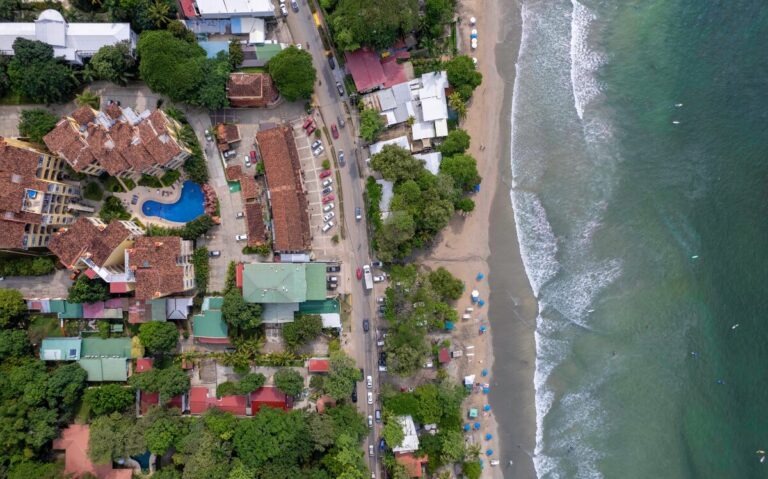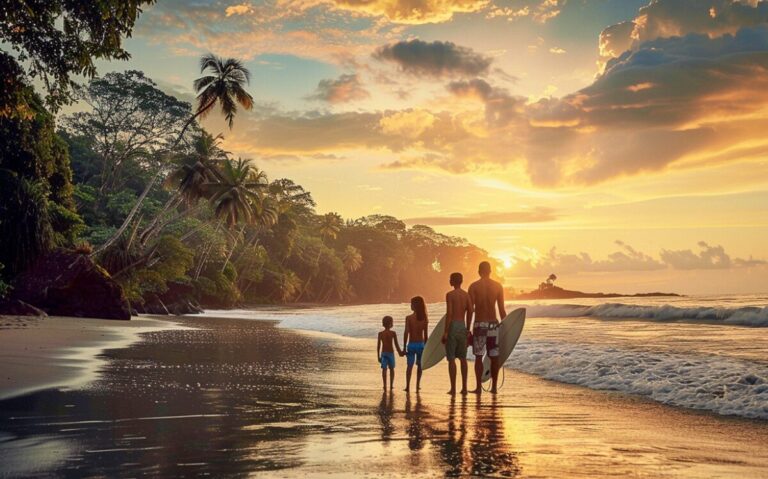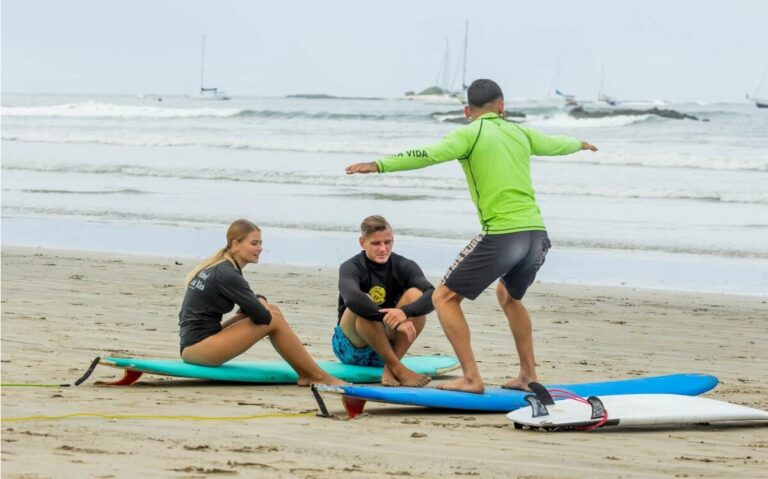Skin & Hair Tips For Your Tamarindo Surf Sessions or Anywhere!
Sun, salt, and sea – these are all part of what makes Tamarindo vacations appealing, but they can wreak havoc on your skin and hair. While the sun-kissed surfer look is something to admire, it’s also something you want to make sure you get safely during your Tamarindo surf sessions in Costa Rica.
Surfer Sun Care
Costa Rica is 10 degrees north of the equator, so the country is always pretty close to the sun as the earth tilts on its axis throughout the year. This makes the sunrise and sunset consistent, rising around 6 am and setting around 6 pm all year, but it also means the UV index is very high year-round, putting visitors at risk for sunburn. This is especially dangerous when you’re surrounded by light reflecting water.

We know people take Tamarindo vacations wanting to get a tan, and trust us – you will, even with diligent sunscreen use. But no one is happy spending their vacation indoors and in pain because they got a bad sunburn, so be sure to wear the proper gear when heading out, especially if you plan to surf.
Here are some tips to spend the vacation of a lifetime surfing in Tamarindo without damaging your skin and hair.
Sun Protection
Sunscreen
There are two types of sunscreens – physical and chemical. Physical sunscreens use minerals like zinc oxide that sit on top of the skin to completely block the sun’s harmful ultraviolet light. Chemical sunscreens, on the other hand, use several ingredients, such as homosalate and avobenzone, to melt into the skin and allow the UV light to absorb into the skin where it creates a chemical reaction and dissipates. Both are effective at blocking skin-damaging UV rays, however, surfers tend to favor pure zinc oxide, especially on their face, as it doesn’t run when it gets wet and is water-resistant. No matter which one you use, make sure it is water-resistant, reef safe, broad-spectrum (UVA and UVB), and has an SPF of at least 30, although it’s probably best to use at least SPF 50 when you’re spending the day in the sun.

Cover Up
On top of sunscreen, there are other physical sunblocks that are important to have on your Tamarindo vacation. A good hat for days you plan to spend long hours outdoors, like on a catamaran cruise or fishing trip, you should have a wide brim that covers your ears and chest. If you’re surfing, or learning to surf, you’ll be in the sun for hours with no shade and no way to keep on a hat or sunglasses but you can wear a rash guard, or rashie, which is basically a surf shirt. This will cover up your shoulders, chest, back, and forearms – the spots on our body that are most susceptible to sunburn. Iguana Surf provides its students with a custom rashie, but they are also available to buy at any surf shop.
Book a surf lesson with Iguana Surf!
Hair Protectors
Your skin isn’t the only thing that needs protection while you’re surfing. Your hair can get damaged from sun and salt as well. There are several types of leave-in conditioners, coconut oil, and even spray-on sunscreens available for hair these days to keep it from getting dry and brittle. One easy way to prevent salt from absorbing into your hair is to wet it with fresh water before hitting the waves.

Sun Damage
The best prevention from causing premature aging of the skin is to protect it from the sun by wearing sunscreen, hats, shirts, and seeking shade whenever possible. After all, up to 80 percent of all visible aging is thought to be caused by the damaging effects of UVA and UVB. Sometimes we forget or get sloppy when it comes to protecting our skin but luckily there are several ways to manage sun damage once it’s already been done.

Vitamin C
Vitamin C isn’t just good for preventing colds and viruses, it is also an important antioxidant that can help to reverse sun damage by fighting free radicals. Vitamin C is also said to help produce collagen in your skin so it helps to puff up the skin and minimize wrinkles. It is also successfully used to treat sunspots, liver spots, or solar lentigines. Not only should Vitamin C be taken internally, it should also be used topically in a toner or serum. There are now several on the market, as people have come to realize what a great anti-aging ingredient Vitamin C can be.
Aloe Vera
Aloe vera isn’t just soothing for a sunburn, it is a powerful antioxidant, antibacterial, and anti-inflammatory that boosts healing, moisturizes the skin, and prevents aging. Aloe vera contains vitamins and minerals, like vitamins C and E and zinc, which is like the trifecta of skin cell protection. Not only will aloe soothe dry, damaged skin, it is also said to fade dark spots caused by sun damage and promote collagen. So don’t wait until you get burned to slap on the aloe! This gentle moisturizer is good for daily use if you have some sun damage you want to fade. Don’t forget about the hair! Aloe can promote pH balance in the hair, scalp, and skin. It can keep your hair from drying out and even protect the color from fading, whether from the sun, or chlorine in pools.

Beer
Beer can be used for more than just a refreshing drink after your surf! The malt and hops found in beer are loaded with protein, which strengthens and nourishes hair. The nutrients found in beer can even help repair dried out, damaged hair to its former glory. The protein in beer binds to hair dehydrated from saltwater, chlorine, sun, and hot weather, and restores strength and body to it. Plus, the alcohol in the beer contains B vitamins that load up your hair with shine. These compounds actually tighten the hair cuticles, which makes light bounce off of your hair, making it appear lighter. You may even see a Costa Rican surfer douse their hair in beer and sit in the sun for a few minutes to help give them that sun-streaked surfer look.
Surfer Routine for Healthy Skin and Hair
Before Your Surf
Before you head out into the waves, make sure you cover yourself in sunscreen. This is best to do after a shower as the product will adhere better to clean, dry skin. It is also easier to fully cover your body with sunscreen when you are naked. Be sure to apply your sunscreen of choice all over your face and body – don’t forget the ears! You can apply an extra layer of protection to the sensitive skin of the face by applying the pure zinc oxide to the burn zones – nose, forehead, and cheeks. Don’t forget, you may have to reapply after a couple of hours, even if you’re using water-resistant sunscreen. Wet your hair with fresh water to protect it from absorbing the saltwater, or spray it with a leave-in conditioner or sunscreen for hair.

We suggest trying out the sunscreen we are selling in the surf shop. Locally made, it’s called New Body and it’s completely natural, reef-friendly, and works great. In fact, it’s a favorite of our surf instructors.
After Your Surf
After your surf, you will want to shower off some of that salt and sunscreen to protect your skin. Don’t let the water get too hot, as it can strip your skin of even more moisture. Use an oil cleanser and then a water-based cleanser for what is called a double cleanse. This will help keep your pores from clogging up by removing the sunscreen from your face, which is notorious for sticking around, especially the water-resistant kind and zinc-based products. After washing and conditioning your hair, you can do a final rinse with beer to gain all the benefits of the protein-rich liquid.

After cleansing, use a Vitamin C toner or serum on your face, neck, and chest. These are the spots on your body where the skin is thin and most susceptible to aging due to sun damage. Allow this to soak in then cover the skin with aloe vera gel – the purer the better (not the green gel). It is best to cover the entire body, especially after a day in the sun and surf. Some people with drier skin will likely need a thicker lotion to apply to their face after these first steps, if so, look for one that contains niacinamide, which helps retain moisture and protects against environmental damage.
Taking measures to prevent damage to your skin and hair from the damaging effects of the sun is important no matter what you’re doing, but it is especially vital for surfers, who are three times more likely to develop Melanoma than the average person. Prevention is the most important thing we can do to protect ourselves against sun damage, so we can look and feel our best, on and off the waves.
By Jennifer LaCharite
















